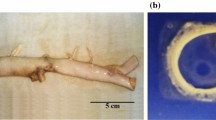Abstract
Elastic lamina growth during development and the ultimate stability of elastin in the mouse aortic media was investigated by light and electron microscopic radioautography. Following a single subcutaneous injection of l-[3,4-3H]valine at 3 days of age, animals were killed at 9 subsequent time intervals up to 4 months of age. One day after injection, radioautographic silver grains were primarily observed over the elastic laminae; however, silver grains were also seen over the smooth muscle cells and extracellular matrix. By 21 to 28 days of age, the silver grains were almost exclusively located over the elastic laminae. From 28 days to 4 months of age, the distribution of silver grains appeared relatively unchanged. Quantitation of silver grain number/μm2 of elastin showed a steady decrease in the concentration of silver grains associated with the elastic laminae from 4 to 21 days of age. After this time, no significant difference in silver grain concentration was observed. Since the initial decrease in grains/μm2 of elastin corresponds to a period of rapid post-natal growth, the decrease is likely to be a result of dilution of the radiolabel due to new elastin synthesis. With the assumption that little or no significant turnover occurs during this time, a constant growth rate of 4.3% per day was predicted by linear regression analysis. Since no significant difference in the concentration of silver grains was observed from 28 to 118 days of age, no new growth or turnover of elastin can be said to occur during this time period. This is supported by the observation that animals injected with radiolabeled valine at 28 days and 8 months of age showed no significant incorporation of radiolabel into the elastic laminae. The results from this study present the first long-term radioautographic evidence of the stability of aortic elastin and emphasize that initial deposition of elastin and proper assembly of elastic laminae is a critical event in vessel development.
Similar content being viewed by others
References
Bendeck MP, Langille BL (1991) Rapid accumulation of elastin and collagen in the aortas of sheep in the immediate perinatal period. Circ Res 69:1165–1169
Berry CL, Looker T, Germain J (1972) Nucleic acid and scleroprotein content of the developing human aorta. J Pathol 108:265–274
Daga-Gordini D, Bressan GM, Castellani I, Volpin D (1987) Fine mapping of tropoelastin-derived components in the aorta of developing chick embryo. Histochem J 19:623–632
Davidson JM, Hill KE, Alford JL (1986) Developmental changes in collagen and elastin biosynthesis in the porcine aorta. Dev Biol 118:103–111
Davis EC (1993) Smooth muscle cell to elastic lamina connections in the developing mouse aorta: Role in aortic medial organization. Lab Invest 68:89–99
Dubick MA, Rucker RB, Cross CE, Last JA (1981) Elastin metabolism in the rodent lung. Biochim Biophys Acta 672:303–306
Fahrenbach WH, Sandberg LB, Clearly EG (1966) Ultrastructural studies on early elastogenesis. Anat Rec 155:563–576
Fischer GM (1971) Dynamics of collagen and elastin metabolism in rat aorta. J Appl Physiol 31:527–530
Fischer GM, Swain ML (1978) In vivo effects of sex hormones on aortic elastin and collagen dynamics in castrated and intact male rats. Endocrinology 102:92–97
Franc S, Garrone R, Bosch A, Franc J-M (1984) A routine method for contrasting elastin at the ultrastructural level. J Histochem Cytochem 32:251–258
Gerrity RG, Cliff WJ (1975) The aortic tunica media of the developing rat. I. Quantitative stereologic and biochemical analysis. Lab Invest 32:585–600
Gerrity RG, Adams EP, Cliff WJ (1975) The aortic tunica media of the developing rat. II. Incorporation by medial cells of 3H-proline into collagen and elastin: autoradiographic and chemical studies. Lab Invest 32:601–609
Kao K-YT, Hilker DM, McGavack TH (1961) Connective tissue. V. Comparison of synthesis and turnover of collagen and elastin in tissues of rat at several ages. Proc Soc Exp Biol Med 106:335–338
Keeley FW (1979) The synthesis of soluble and insoluble elastin in chicken aorta as a function of development and age. Effect of a high cholesterol diet. Can J Biochem 57:1273–1280
Keeley FW, Johnson DJ (1983) Measurement of the absolute synthesis of soluble and insoluble elastin by chick aortic tissue. Can J Biochem Cell Biol 61:1079–1084
Kopriwa BM (1973) A reliable, standardized method for ultrastructural electron microscopic radioautography. Histochemie 37:1–17
Kopriwa BM, Leblond CP (1962) Improvements in the coating technique of radioautography. J Histochem Cytochem 10:269–284
Lee I, Yau MC, Rucker RB (1976) Arterial elastin synthesis in the young chick. Biochim Biophys Acta 442:432–436
Lefevre M, Rucker RB (1980) Aorta elastin turnover in normal and hypercholesterolemic Japanese quail. Biochim Biophys Acta 630:519–529
Looker T, Berry CL (1972) The growth and development of the rat aorta. II. Changes in nucleic acid and scleroprotein content. J Anat 113:17–34
Nakamura H (1988) Electron microscopic study of the prenatal development of the thoracic aorta in the rat. Am J Anat 181:406–418
Reynolds ES (1963) The use of lead citrate at high pH as an electron opaque stain in electron microscopy. J Cell Biol 17:208–215
Ross R, Klebanoff SJ (1971) The smooth muscle cell. I. In vivo synthesis of connective tissue proteins. J Cell Biol 50:159–171
Rucker RB, Tinker D (1977) Structure and metabolism of arterial elastin. Int Rev Exp Pathol 17:1–47
Shapiro SD, Endicott SK, Province MA, Pierce JA, Campbell EJ (1991) Marked longevity of human lung parenchymal elastic fibers deduced from prevalence of d-aspartate and nuclear weapons-related radiocarbon. J Clin Invest 87:1828–1834
Slack HGB (1954) Metabolism of elastin in the adult rat. Nature 174:512–513
Walford RL, Carter PK, Schneider RB (1964) Stability of aortic elastic tissue with age and pregnancy in the rat. Arch Pathol 78:43–45
Author information
Authors and Affiliations
Rights and permissions
About this article
Cite this article
Davis, E.C. Stability of elastin in the developing mouse aorta: a quantitative radioautographic study. Histochemistry 100, 17–26 (1993). https://doi.org/10.1007/BF00268874
Accepted:
Issue Date:
DOI: https://doi.org/10.1007/BF00268874




